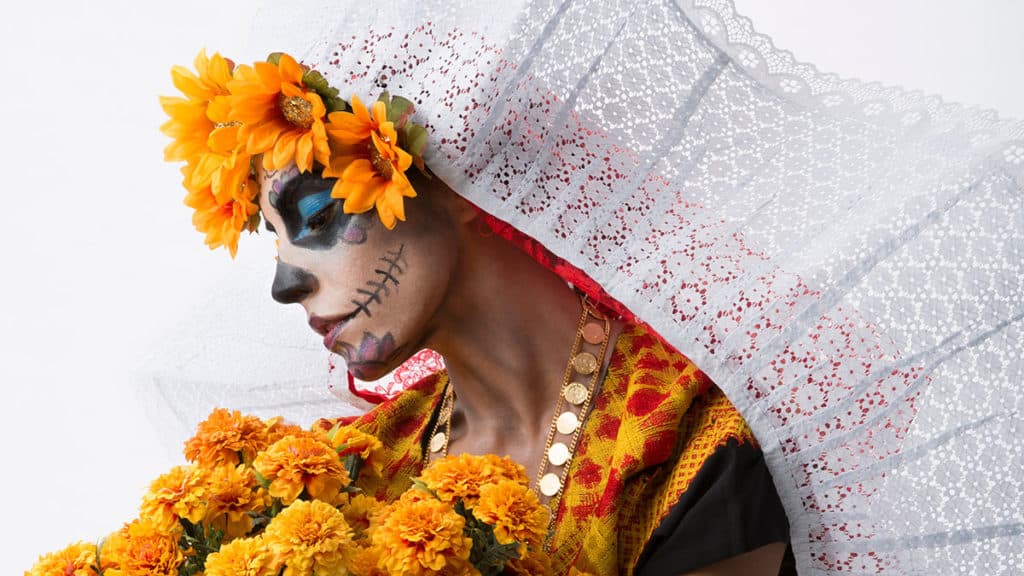Calpulli Día de los Muertos is a Broadway-style show that brings the Day of the Dead, the Mexican family celebration of life, to the stage with rich storytelling, beautiful costumes, great music, and impressive dancing.
Calpulli “Día de Los Muertos”

Calpulli Mexican Dance Company “Día de los Muertos,” folkloric dance theatre about Mexico’s Day of the Dead celebration for the entire family; is at the Flatiron Nomad Partnership’s Día de Muertos celebration at the Flatiron Public Plaza in Manhattan’s Flatiron District; on Wednesday, November 1, 2023 at 3pm. FREE. Interestingly, they use the Mexican Spanish name for Día de Muertos, not the American Spanish Día de los Muertos. flatironnomad.nyc 🇲🇽
Calpulli Mexican Dance Company “Día de los Muertos,” folkloric dance theatre about Mexico’s Day of the Dead celebration for the entire family; is at Queens Theatre in Flushing Meadows Corona Park, Queens; on Saturday-Sunday, October 28-29, 2023. From $30. There is a special 20th Anniversary performance and reception Sunday, November 5, 2023 at 3pm. $102. queenstheatre.org 🇲🇽
The show debuted at The Town Hall in Midtown, Manhattan. It’s also been performed at Hostos Center in Mott Haven, The Bronx.
We saw the World Premiere at The Town Hall. Calpulli Mexican Dance Company is a community dance company, yet the production is Broadway-quality in every dimension. How they achieve this level of excellence with community artists and just a few professionals, is some kind of New York miracle. It’s a tribute to recently promoted Artistic Director Grisel Pren Monje.
Calpulli “Día de Los Muertos” Synopsis
The show is a love story that spans the boundary between the living and the departed.
A loving couple falls victim to treachery and is separated, seemingly forever. The young woman enters Mictlán – the underworld of Aztec mythology – where the mesmerizing Catrina reigns as queen. But nothing gets in between true love.
Folkloric and classical music mix with vibrant dances, colorful costumes, makeup and beautiful set pieces to bring this beautiful love story to life.
Aztec and Mayan Traditions
Aztec and Maya traditions, in fact many ancient traditions around the world, practice ancestral veneration, and see life and death as two sides of the same thing. So we don’t fear death.
Skull Catrina la Calavera Garbancera, the icon of the Day of the Dead, is a modern representation of Mictlancihuatl, the Aztec goddess of the underworld. She guards the bones of the dead, but there is nothing scary about her. We love her because every morning, she swallows the stars to make the day.
The Aztec celebration was a late summer festival. Colonial Spanish priests moved the festival to their own All Souls Day. Both traditions see these days as a time when the boundaries between the living and the dead are loosened. The departed can cross back over and visit, but only come if you invite them. That’s why we make ofrendas (family altars) for our deceased loved ones. The ofrenda is the invitation.
European Traditions
In classical European literature, Calpulli’s “Día de los Muertos” is the story of Orpheus and Eurydice, although sort of in reverse. That makes sense partly because Aztec/Mayan and European concepts of the underworld are reversed. European tradition fears death and sees the underworld as some kind of hell. In Mexican Aztec tradition, death is reality and life is just a dream. The Aztec underworld is the equivalent of European heaven. We don’t fear death. It is the one universal experience in life.
Orpheus is the ancient Greek god of poetry and music. When his wife died, Orpheus missed her so much that he entered the underworld to find her. The boss of the underworld agreed to let her return, but only for half the year. When she is gone, Orpheus mourns and we face the cold sorrows of the fall and winter seasons. When Eurydice returns we experience the warm joys of spring and summer.
So happy Día de los Muertos. On the Day of the Dead, may you always be remembered!
